The reasons for the appearance of parasites
Almost all gardeners know the old folk belief, which, unfortunately, is used only by the elderly. The flower or plant you like must be bought from its previous owner for a small amount of money or stolen. More precisely, just pinch off a small sprout from a flower, but so that no one will notice. And to be honest, such flowers live for a long time, while no infection sticks to them, they do not get sick or wither. Only this does not mean that it is enough only to water the plants, especially the phalaenopsis orchids.
Receiving worthy care, the flower will give its owner its beauty, charm and unsurpassed aroma. The younger generation does not take folk sayings seriously, and mostly buys indoor flowers in specialized stores. It is such a purchase that is more at risk of pest damage.
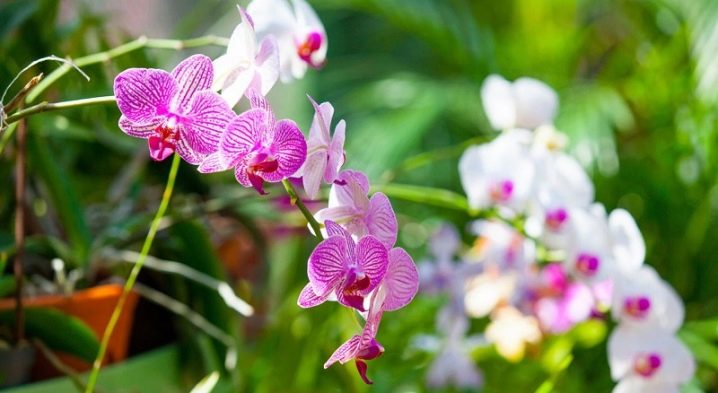
In order to protect yourself and the purchased plant from possible pests in advance, you should know the most frequent methods of their distribution.
Quite often there is such a situation that an already infected orchid is purchased at a flower shop. That is why, during the purchase, it is necessary to carefully inspect and study all parts of the flower. But not only from the outside, but also from the inside. You should look into the sinuses of the leaves
It is very important to check the bottom of the plant and the soil in which the flower is located. If you find any insects or their rudiments, it is best to refuse to purchase.
Also, parasites can be located in the substrate used for transplantation.
Novice flower growers often face a similar problem, as they use the soil dug out in their own backyard. Your best bet is to spend some money and get a small bag of soil for planting from a specialized department.
If you do not keep track of existing plants, the orchid can infect with parasites from neighboring flowers. Especially if there are a lot of flowering varieties and they are located at a close distance from each other. Without proper care, the situation will unfold as follows: in one pot a favorable environment has developed for the emergence of harmful insects, after a while barely noticeable bugs appeared. After drinking all the juices from a flowering and healthy plant, the insects move to the next flower, and so on along the chain.
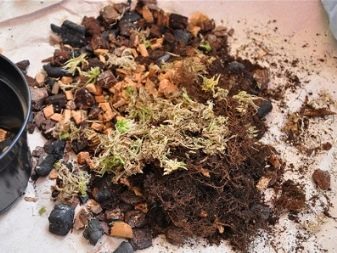

Reasons for the appearance of bugs
In some cases, insects enter the flower along with the substrate. This cannot happen with purchased soil. Most likely the cause was some of the components of the self-assembled substrate. Bugs, aphids and other insects feel great on unpeeled moss, on pieces of unpeeled bark. Some types of pests get on the flower from sand or fern pieces.
Another common cause is mistakes in beauty care. This applies to watering. Excessive watering provokes the development of various diseases of the root system. The plant weakens and cannot actively resist various damaging factors. As a consequence, it is affected by pests.
But not only excess moisture is harmful to the orchid. Lack of moisture and watering is also very dangerous for a beauty. Some insects live well only in low humidity and tend to rooms where such conditions are constant. During such periods of life, he withers due to lack of moisture, as well as from rampant parasites.
A very important factor in the defeat is the transition of insects to a healthy orchid from a neighboring pet. You can endlessly treat your pet for parasites, but if you do not eliminate the source of infection, then nothing will work.
Red spider mite
How to get rid of such a tick on an orchid, what control measures are there? The red spider mite is a small insect up to one millimeter long. Adults have eight legs, and the larvae have six. Their danger lies in very rapid reproduction and too high voracity. In addition, they often spread to neighboring plants, they can hide in the soil and fallen leaves.
Most often, the red spider mite enters the room with newly acquired plants. Therefore, when buying an orchid, you need to examine it as carefully as possible, and after completing it, place the plant separately from others and observe it for several weeks. As a rule, mites are placed on the inside of the leaf, pierce it and begin to actively suck out the juice, the leaves are covered with light spots, and then a thin web.
Also, the appearance of this pest is provoked by high air temperature, low air humidity and excessive feeding. Damaged transplanting soil can contribute to infection, the tick can enter the house through the wind and even be carried on clothes.
If the infection is not yet on a large scale, you can use an ordinary solution of green or laundry soap. Using a soft cloth or cotton wool soaked in liquid, you need to rinse the inside of the leaves, and then spray the entire plant with a spray bottle. After a week, this procedure must be repeated.
With a more severe infection, you can use the following, more effective means:
- Taking two chopped heads of garlic, place them in a glass container, pour one liter of water and place in a dark place for a week. Then strain the infusion, dilute it halfway with water and spray the orchid.
- Pour one hundred grams of onion husks with three liters of water and insist for five days, strain and spray the plant.
- It helps well in the fight against spider mites, rubbing with alcohol or irradiating the inside of the foliage with ultraviolet light.
- To remove eggs, wipe the affected area with essential oils.
If the above methods do not help, you need to apply insecticide spraying (Aktellik, Fitoverm, Neoron, Aktofit, Vermitic and others).
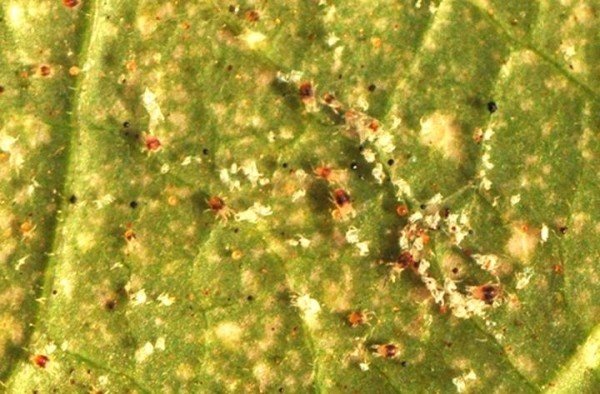
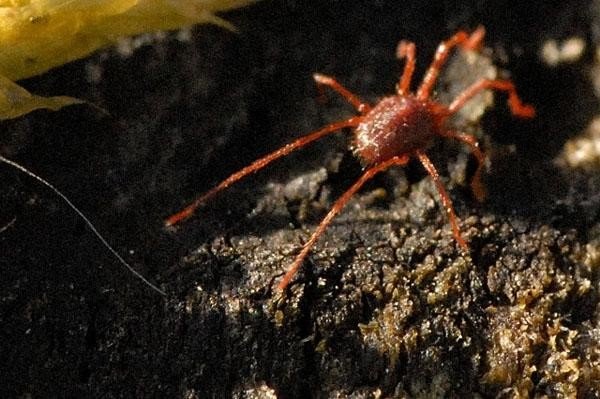
Orchid pest prevention
Many parasites that end up in the same pot with an orchid are very problematic to remove. Therefore, it is much easier to prevent infection of the flower than to treat it.
The main preventive measures that will help protect the orchid from parasite infestation include:
- periodic preventive treatment of the flower with standard pest control agents;
- daily examination of the beauty to identify even the smallest deviation from the norm; the correct water regime, which will avoid creating favorable conditions for insects;
- using only clean tools when transplanting and pruning a plant;
- transplanting a flower into a new pot immediately after purchasing it;
- no clusters of flowers on one windowsill.
All of the above preventive measures will minimize the risk of pests on the orchid. However, for full protection, you also need to properly care for the plant so that your beauty can successfully resist the invasion.
Ways to fight
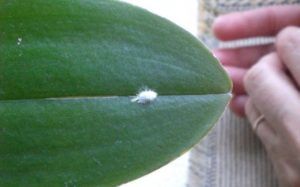 In order to prevent the spread of mealybugs to all pets, it is necessary not only to water the plant, but every time to carefully examine it for the presence / absence of pests.
In order to prevent the spread of mealybugs to all pets, it is necessary not only to water the plant, but every time to carefully examine it for the presence / absence of pests.
If this did happen, then:
- The orchid must be urgently isolated, be sure to check the nearby plants;
- Remove visible worms with cotton swabs by wetting the sticks with vodka, calendula tincture or water;
- Arrange a hot shower of 40-50 degrees for the orchid, which is destructive for the mealybug;
Folk methods
When there are no chemicals at hand or there is no desire to use them, you can prepare folk remedies:
- Garlic tincture. Crush or grate 5 cloves of garlic, pour 0.5 liters of boiling water, leave for 4 hours, filter, grease the leaves and tubers with a brush with undiluted solution;
- Vodka with soap. For 1 liter of water 15 gr. liquid soap and 10 ml of alcohol or 20 ml of vodka. It is applied to places of accumulation of insects. You must first try on a small area of the orchid, as there are plants that are very sensitive to alcohol;
-
Oil solution. 1 liter of warm water, 2 tablespoons of olive oil, mix thoroughly and spray the flower;
- Horsetail decoction. 100 g Pour horsetail with 1 liter of boiling water, cool to 40 - 50 degrees, spray the orchid.
After these procedures, it is necessary to thoroughly blot the leaf axils and the growth point.
Mechanical cleaning
Without mechanical cleaning, getting rid of the mealybug will be very problematic. What does it consist of:
- We clean the orchid from visible pests with a damp swab or cotton swab;
- If the peduncle or buds of the plant are affected, it must be cut and discarded;
- From old leaves, dry scales remain on the stems / pseudobulbs - they must be removed, since there may be clutches of eggs or the worms themselves. Remove the latter with a damp swab;
-
Mealybugs like to settle on young leaves or sprouts of orchids, which have concentrated a large amount of amino acids. It is quite difficult to remove the pest from there. You can try to do this with a toothpick or soak the orchid removed from the substrate in a soapy solution - the worms themselves will crawl out of there;
- If the plant is sympodial, remove the covering leaves from the young pseudobulb, they still do not live long.
Important! The orchid must be transplanted into fresh soil by treating the roots with an insecticide or one of the folk remedies. In case of extensive damage, treat the plant with a fungicide .. To prevent re-infection - the window sill, the glass is washed with detergents, the curtains are washed
You can treat the plant with fungicides
To avoid re-infection - the window sill, the glass is washed with detergents, the curtains are washed. You can treat the plant with fungicides.
Chemicals
Chemicals are available in two types:
- Granules or sticks. This is not suitable for orchids because of the composition of the soil in which they grow and the content of fertilizers in the preparations themselves;
- Liquids or emulsions. Oil emulsions are applied to areas where insects are sitting. But you need to know: since the oil clogs the stomata of plants, this leads to death of flowers in large areas of damage by the pest.
 In turn, liquid preparations are divided into:
In turn, liquid preparations are divided into:
- Contact - damaging pests in contact with the insect itself, is effective only on young individuals. These include Fozalon;
- Gastric - enters the stomach of the worm through the mouth opening. Aktelik, Aktara, Vertimek;
- Systemic - when using this agent, the plant absorbs it into itself, becoming poisonous to parasites. Phosphamide, Rogor.
Substances acting on the mealybug:
- Malathion;
- Diazinon;
- Dimethoad;
- Parathion.
To get rid of the mealybug with a guarantee, it is necessary to carry out 4-5 treatments every 7-10 days with preparations with different active ingredients. During the processing period, the flower should not be kept in bright sunlight.
What can cause white bloom?
- The main factor for the active spread of the fungus on the orchid is too high air humidity and too intense spraying. For some types of orchids, such as phalaenopsis, foliar irrigation is completely contraindicated.For many other species, spraying is shown only to the root system.
- The second factor is very intensive watering. If not only signs of a fungus damage to the flower appeared, but the roots or the stems themselves began to rot, then it is necessary to limit the number of watering (more about whether it is possible to save the orchid from rot and what are the reasons for its appearance, we talked about here).
Watering the orchid is necessary only when the entire substrate is dry. Watering is done by immersing the pot in water for about 30 minutes.
- The third factor is too cold or too hard water. It is advisable to water the orchid with bottled or rain water, letting it settle beforehand. The water should be at room temperature.
- The fourth factor is stagnation of moisture in the core or axils of the leaves. To avoid this - after spraying and watering, be sure to remove water from the axils of the leaves or from the core of the outlet.
- The fifth factor is the too high temperature in the room where the flower lives. If the heat is combined with high humidity, the fungus on the orchid will not be long in coming.
- The sixth factor is dead leaves and flowers not removed in time. From them, the fungus can first infect the soil, and then the entire plant as a whole.
Mushroom gnats (sciarids) on an orchid
If you collect cacti that are very rarely watered, then you are unlikely to ever find sciarids in your flowerpots. Mushroom gnats live on the upper part of the soil and most often appear in the spring from the moment the central heating is turned off, when it becomes damp and cool on our windowsills, respectively, the substrate dries out longer, the room has high humidity - these are the main aspects for their appearance. It is very easy to get rid of these insects, first of all you need to limit watering as much as possible and let the soil dry completely or cover the top layer with sand. If sciarid larvae are in the flower pots, it will be ideal not only to replace the top layer of the soil, thus getting rid of most of the larvae, but also to cover the surface of the substrate with soil insecticide.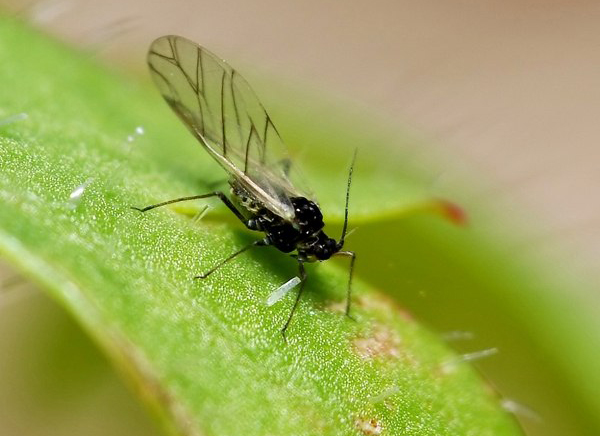
Also, traps - sticky yellow tapes or a fumigator - can be used to control flying insects.
Control measures
 How to get rid of a pest? The first urgent step when a scabbard is found is to separate the infected specimen into a quarantine zone.
How to get rid of a pest? The first urgent step when a scabbard is found is to separate the infected specimen into a quarantine zone.
This is necessary so that the males do not run over to neighboring flowers. Especially if the flowers are very dense.
All the time of treatment, the flower is in the quarantine zone and even 2 weeks later it remains in it. This is necessary in order to be completely sure that the pest is no longer on the flower.
The way to get rid of the scabbard:
- It is necessary to mechanically remove all visible shields, since no chemical will get under them during processing;
- Wash all leaves and peduncles with soapy water, getting rid of sticky plaque;
- Only after that they start processing the plant.
If the infection is small, then you can try to get rid of the insect using folk methods, but with a large defeat, they do not give results.
Folk remedies
How to deal with scale insects folk remedies? Since this is not a new pest and people have been struggling with it for a long time, that is, certain folk remedies to get rid of it.
Garlic juice
To do this, cut off the tip of the chive and, with the help of the protruding juice, process the places on the leaf plates where the pest was noticed.
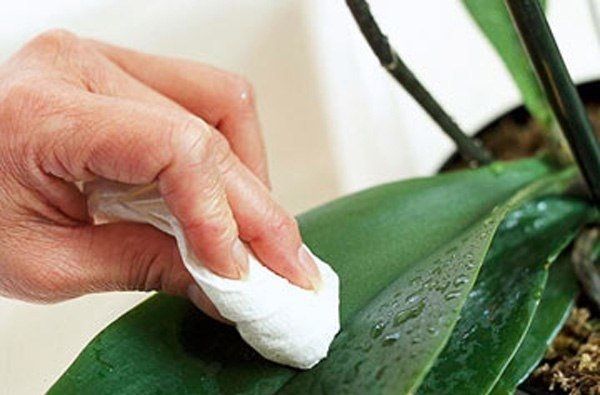
A folk remedy for fighting scale insects is rubbing orchid leaves with garlic juice.
But if the damage takes up a large area, then the garlic is rubbed on a fine grater or crushed by another method, the main thing is that it let the juice out and turn into gruel. Then this gruel is spread on the affected leaf.
Olive oil
To do this, make a composition by mixing 2 tbsp. tablespoons of oil with a liter of water. The orchid is treated with this infusion three times with an interval of 7 days.
Soap and alcohol
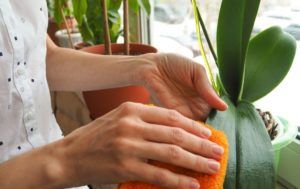 To do this, you need to mix:
To do this, you need to mix:
- Litere of water;
- And 10 ml. alcohol;
- By adding there 15 gr. liquid soap or dishwashing detergent.
Everything is thoroughly mixed and the plant is washed with this, where the scale insect was noticed.
Biological agents
Fitoverm - quite good at fighting the shield. It is used in cases where, for various reasons, it is impossible to carry out chemical treatment, and folk methods do not help to completely get rid of it. This drug is of biological origin and is not dangerous for humans and their animals.
To make a solution of the drug, 2 ml. bred in 200 gr. water and spray the affected plant. This drug can be used to treat the rest of the plants in the house for the sake of disease prevention. And also it is necessary to wipe the place where the affected flower stood.
To completely remove the scabbard, the treatment is carried out three times after 7 days.

Fitoverm.
Promanal - is considered non-toxic and is used at home not only against various types of scale insects, but it helps well to get rid of ticks and worms. Acts on clutches of eggs, the larvae die without hatching. When processing an orchid, it must be thoroughly sprayed so that the solution drips from the leaves. In this case, it is necessary to process the substrate, as it may contain eggs and larvae.
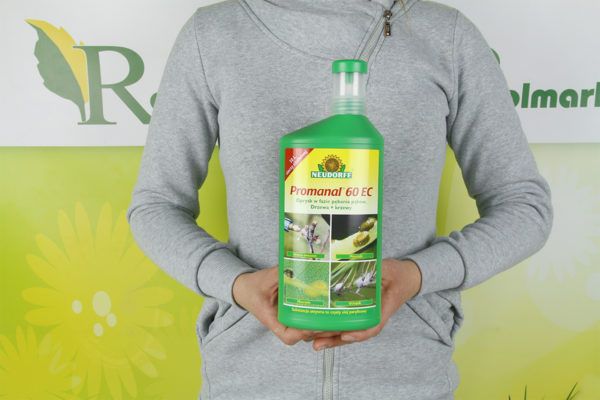
Promanal is a product that helps plants fight pests.
Avertin is a broad-spectrum drug designed to remove pests. It affects the nervous system of the pest, causing paralysis. Processing is carried out according to the instructions on the package.
Nematode - the weapon of this biological product is a nematode, which enters the scale insect larva and eats it. The drug is absolutely harmless to beneficial insects, people and pets. The nematoda continues to fight the pest for quite a long time, and the latter has no chance of surviving against it.
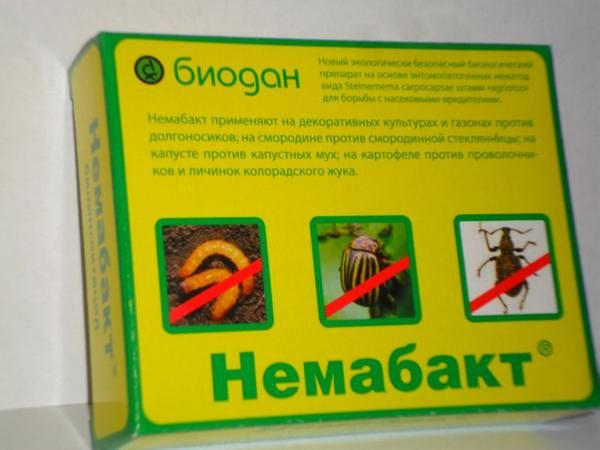
Biological product Nemabakt.
Insecticides
If the orchid is completely affected by this harmful insect, then it is worth using chemicals that can save the plant. When working with such drugs, one must be careful and if it gets on the mucous membrane or skin of a person, it is necessary to rinse everything well under running water.
Permethrin
The drug is quite effective and one treatment is enough to remove the parasite.
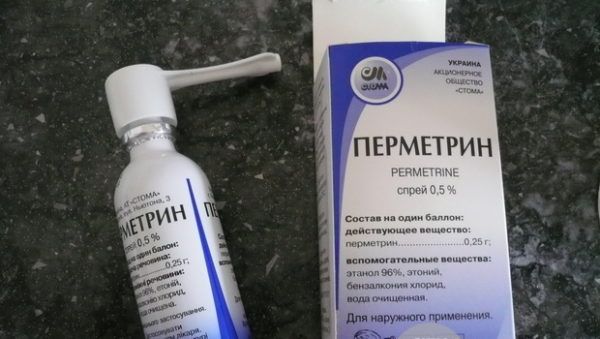
Permethrin is good for helping the orchid fight pests.
Penetrates into the scabbard through the skin.
Actellic and Aktara
These drugs are treated three times with an interval of 5-6 days. It is very toxic and must be processed outdoors. Penetrates insects through the oral cavity.
Phosphamide and Methylmercaptophos
The drugs enter insects through the sap of the plant, which becomes poisonous after processing.
Whichever drug is chosen, it is diluted and used according to the instructions given on the package. Experienced growers believe that sometimes chemical treatment cannot be avoided when a large area in the greenhouse is infected or the flower itself is severely damaged by pests.
IMPORTANT! It is not necessary to increase the dosage or the frequency of treatments - this can lead to the death of the plant.
How and how to process?
Traditionally, flower growers distinguish folk and chemical remedies... Chemicals release toxic elements, quickly kill parasites, but can be dangerous to animals and humans. It is recommended to use them only in case of mass infection.
Chemical treatment
Funds are additionally divided into groups according to the mechanism of action. The poison can enter the body of the parasite by contact or intestinal routes, and have a systemic effect.
Specific drugs to combat parasites.
- Aktara. Systemic action. The range of applications is wide (thrips, scale insects, aphids and others). Has 3 class of hazard.
- Actellic. Works against ticks, flea beetles, aphids, scale insects. A single use is usually sufficient. 2 class of hazard.
- Karbofos. The same pest complex. 2 class of hazard.
- BI 58. A universal remedy with a strong effect.One treatment is enough.
- Acaricides used to combat ticks. These are Antiklesch, Fufanon, Neoron, Omite.
Orchid processing is undesirable to carry out in living quarters. Chemicals are toxic, they pose a threat to all living organisms. The safest chemicals are 3 or 4 hazard classes.
Traditional recipes for treatment
When small colonies of indoor pests appear, herbal decoctions or infusions can be prepared. Suitable for these purposes:
- chamomile;
- yarrow;
- marigold;
- nettle;
- citrus peels.
Pour raw materials with boiling water or boil, leave for up to 24 hours, spray orchids through a spray bottle. Repeat the treatment daily. Steamed citrus peels can also be dug into the ground: their specific smell will drive away parasites.
What other tools are allowed to be used at home?
- Mix olive oil with water (2 tablespoons per 1 liter). Apply the resulting liquid with a brush to the affected leaves.
- Chop the onion until a gruel is obtained, pour boiling water over it, leave for up to 7 hours. Strain the product and use for spraying. The course of treatments is 3-4 days, several times a day.
- A decoction of cyclamen tubers. Cut the tubers and boil for 30-40 minutes. Without taking out the cyclamen, infuse the liquid for a day. Then strain and spray. Processing is allowed to be carried out several times a day, but with a mandatory interval of 4-5 days.
Biological
Their difference lies in their safe action. They are based on plant components and a small percentage of poison. Substances from the composition do not accumulate in orchids. Pests do not get addicted to such drugs. Some biological agents additionally enhance plant immunity.
Preparations related to biological:
- Bicol.
- Lepidocide.
- Verticillin.
- Fitoverm.
- Nemabakt.
Prophylaxis
 All plants need to be examined regularly, especially carefully - young shoots and leaves, buds and flowers, since it is these parts that most attract the mealybug.
All plants need to be examined regularly, especially carefully - young shoots and leaves, buds and flowers, since it is these parts that most attract the mealybug.
It is also important to observe the correct care of the orchid - you need to monitor the temperature, humidity and ensure proper watering
Particular attention should be paid to orchids in winter.
Often, beetles enter the house with a new plant. To avoid this problem, you should carefully examine the green pet before purchasing. If it is not easy to notice small bugs in the peduncles and the core of the orchid, then it is impossible to find them in the ground, so at home the pot with the newly purchased orchid should be immersed in a bowl of water for five minutes. The water should almost cover the surface of the substrate. After a specified time, the pests, if any, will get out of the soil. Also, it makes sense to set quarantine for a month for each new plant.
The main reasons for the appearance of parasite bugs on orchids
Have you ever analyzed the reasons for the appearance of a mosquito or midge on your beautiful body?
- Forgot to apply a special cream or ointment?
- Is the ointment (cream) bad? But I asked the seller to be good!
- Have you forgotten the natural and elementary conditions? This is their way of life. Only there are suitable conditions - they appear.
So with pests. They do not appear on a bare spot. You have acquired a wonderful plant. Orchid. Some people have never heard such a name in our area. And the pests are so familiar. And why did they start?
Important! Do you know the orchid variety? Have you created the right conditions for her? And what could be the reason for the appearance of unwanted guests?
You first analyze your actions. Before looking for the culprit.
Overflow
How should you water? The general rules are:
- Each species is watered in a way that suits it;
- Excessive watering does not allow the substrate to dry out;
- In a substrate oversaturated with moisture, various bugs can start;
- Overflow leads to stagnation of moisture, makes the substrate unusable. And it creates conditions for those who like to profit from orchids.
Poor quality substrate
Insects in the ground are not uncommon.The appearance and presence of orchids in the house requires the creation of optimal conditions for them:
- A high-quality substrate will help plants grow actively. It supplies the plants with the necessary nutrients;
- It is not easy to take land from the forest or from the garden. Epiphytic orchids are selected with a special substrate. With coniferous bark, charcoal, peat and moss. With good water holding capacity and air permeability;
- The risk of bug pests in the soil for orchids will be much less. If you purchase a substrate in specialized stores for a specific type, you will be offered the appropriate option;
- When self-preparing the components of the substrate (especially the bark), be sure to carry out the heat treatment procedure;
- And treatment with preparations from insects and bugs. If you process the container, this will also not be superfluous.
Buying an infected plant from the store
Often, parasites get to your pets with new acquisitions. They are treated with various drugs for sale. But where and how much can they be? And what kind of plants are on sale nearby? And pests are usually not that specific. And many are common to indoor plants.
So many growers advise when buying to carefully examine the plant for the presence (absence) of external signs of pests:
- Various points, cobwebs, Gauls suggest their presence;
-
And it is undesirable to take home a breeding ground of pests. Quarantine may not help either.
Here growers with experience can deliberately buy a plant with bugs. If they know what these insects are and what to do with them. But the price is reduced significantly.
Infection from other indoor flowers
The situation is very similar:
- Orchids have appeared not so long ago. But many have roses, violets, "Ladies' happiness" in the home collections of flower lovers;
- And pests appear. Aphids, spider mites and thrips are not uncommon. Their mobility is simply amazing. They move to healthy plants very quickly.
Advice! The quarantine for purchased plants must be respected. This is also a reason to have a good look at home flowers. Are there dangerous bugs on them?
Spider mite description
Pest type
The spider mite (Tetranychus urticae) belongs to the arachnids, from the spider family. The size of the family is so large (more than 1000 species) that the distribution is ubiquitous, except perhaps Antarctica. Below in the photo you can see a common type of spider mite.

The spider mite belongs to the spider family.
It is quite difficult for a flower grower to find it, due to its very small size. Even a well-fed mite does not exceed 0.5 mm, while they:
- Soft-bodied;
- With a convex top and a flat bottom;
- Ellipsoidal type.
The color, depending on the stage of development, changes markedly. Larvae by themselves:
- Transparent;
- With dark spots on the sides.
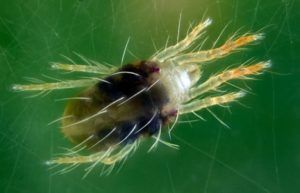
Depending on the culture, they have a color from light green to green-brown. Unlike the adult pest, which has 4 pairs of legs, the larvae have 3 pairs.
The color of spider mites is varied, but on orchids it is usually green or red. White mites are also occasionally found.
Unlike most insects, the spider mite lacks antennae, but it has strong heart-shaped jaws and two stylets that help to bite into dense leaves.
Features of life
A feature of such pests is the ability to weave a web. As a result of this, such a name. Another representative - Tenuipalpus pacificus or red ticks, called false, do not weave a cobweb, so it is very difficult to detect them. Its other name is false ticks.
Attention! The main location of spider mite colonies is the inner side of the leaf, therefore, the presence of a pest can not always be detected visually.
With their strong jaws, they bite through a leaf plate for feeding with juice.He injects a special substance, which, penetrating into the cells of the leaf membrane, forms a juice, which is the main food of the malicious pest.
As a result, the leaf begins:
- Turn yellow;
- Small translucent dots appear on it;
-
And in a short time, the leaf dries out completely.
With the loss of each leaf, the following is significantly reduced:
- The efficiency of photosynthesis;
- Plant development;
- And soon it stops altogether and it dies.
It is especially offensive when a colony of ticks bites into flower petals. The entire aesthetic appearance of a blooming tropical beauty is violated.
Favorable climate for life, reproduction and distribution
Ticks can reproduce all year round when:
- Dry air;
- With humidity below 40%;
- Ambient temperatures above 25 ° C.
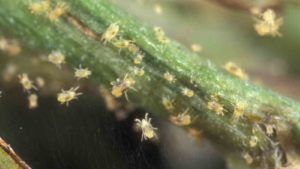 Under unfavorable conditions for themselves, they fall into a state of diapause. The female can lay about 200 eggs in groups of different numbers.
Under unfavorable conditions for themselves, they fall into a state of diapause. The female can lay about 200 eggs in groups of different numbers.
After the 3 day stage, larvae emerge from the eggs. The developmental stages are very fast. Within a week, the larva turns into an adult with the ability to reproduce.
Females can lay their eggs anywhere, from the roots to the walls of the container. Surprisingly, under uncomfortable conditions for the development of egg colonies, they stop their development, which can restore its vital activity even after 5 years.
The life cycle is highly dependent on the environment. Full stage of development depending on the ambient temperature:
- t-20 ° С - 20 days;
- t-25 ° С - up to 12 days;
- t-30 ° С - up to 6 days.
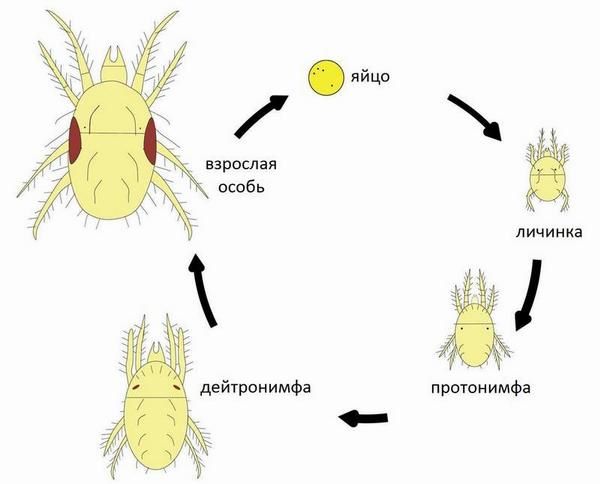
Stages of tick development.
Life expectancy under comfortable conditions is 15 to 30 days.
The light, weightless mass of the spider mite allows it to enter the home flower garden not only with newly acquired plants, but also through open windows from the street.
Symptoms and causes
On domestic orchids, the most common are true (green) and false (red) ticks. White mites can cause orchid disease.
Below you can see the shell mite in the photo (black).
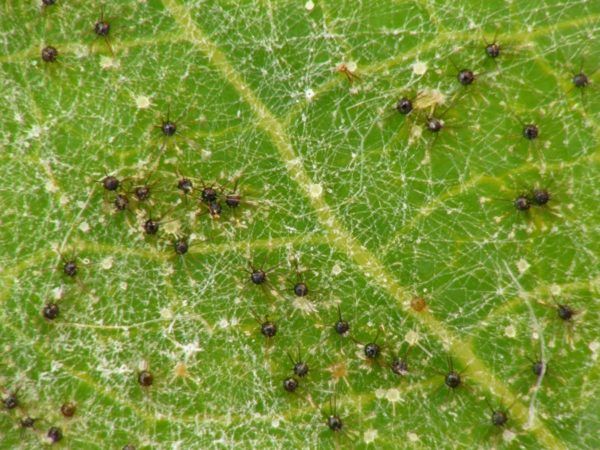
Usually spider mites appear on the back of the leaf.
Symptoms of the appearance of a pest on a plant are:
- A cobweb, located in most cases on the back of the leaf plates;
- The appearance on the leaf plates of white spots that increase in size over time;
- Twisting and drying of the leaf apparatus.
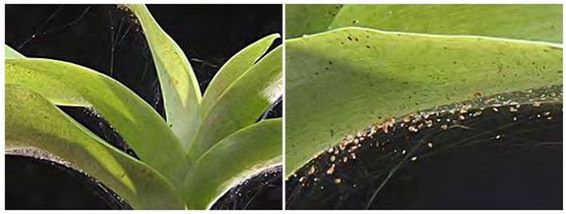
The cobweb is one of the symptoms of the appearance of a pest.
The reasons due to which the pest appears on orchids at home are very diverse:
- It can be brought in with newly acquired plants;
- Put on clothes;
- Fly into an open window or window;
- Eggs can be in untreated soil or in an old flower pot.
Attention! A spider mite can appear wherever acceptable conditions for life support it.


